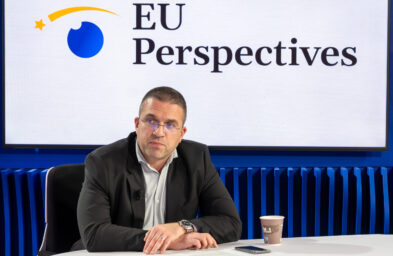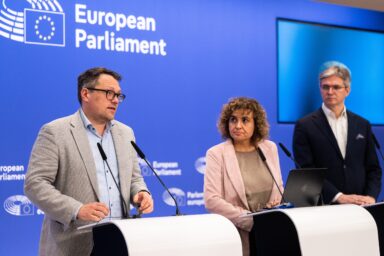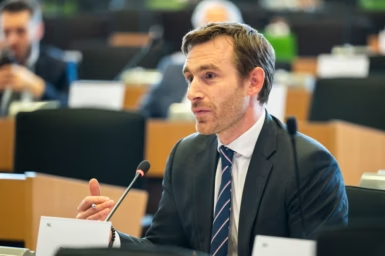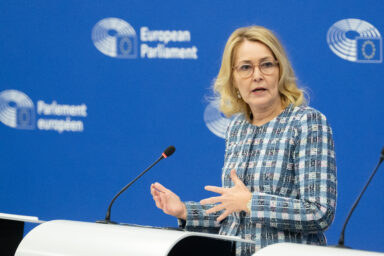The new European directive extending liability for wastewater treatment imposes steep costs on pharmaceutical manufacturers. It threatens to wipe out many critical drugs – particularly the low-cost, high-volume generics – from the market. The producers are suing. Is the pharmaceutical industry unfairly singled out for wastewater pollution? Is there a better way of dealing with drug residues in European waters? And what is next for the legal action? EU Perspectives tackled these questions with Adrian van den Hoven, Director General of Medicines for Europe, an association representing the generic medicine industry.
The pharmaceutical companies you work with have filed a lawsuit against the directive. Could you maybe in the beginning explain why you are concerned about the directive?
Let me give you a little bit of background about the directive. It is basically about the regulation of the treatment of urban wastewater. The part that we’re concerned with is a requirement on the pharmaceutical industry and the cosmetics industry to finance the infrastructure and the operational cost of the fourth level of treatment. What’s important to underline is that this is not related to pharmaceutical production, it’s not related to the factories we have in the EU member states. Of course, we are obliged to control very strictly the release of the water from those factories according to all the legislations of the EU and the member states. But this is about the human consumption of the medicine. Let’s say probably in Europe there are about 15 to 20 billion boxes of medicines consumed a year, and then the patients excrete part of the unmetabolized medicine in the water. So the idea is that the pharmaceutical industry should pay for this.
What is wrong with the idea?
You might be interested
First of all, it’s a very unusual way of using the “polluter pays” principle because it’s about human consumption of medicines. Secondly, it is very very poorly thought through. First of all, the evidence is not at all clear that the pharmaceutical industry and cosmetics industry are responsible for 92 per cent of the pollution in the urban wastewater. Secondly, this levy will fall mainly on very inexpensive generic medicines, rendering them economically unviable. So it will no longer be economically possible to manufacture and commercialise these medicines. And some of these medicines are absolutely essential for diabetes, for epilepsy, for bacterial infections, etc. So from a public health perspective, we cannot stop producing and marketing these medicines, but from a cost perspective, it will be impossible to continue to do so.
What do you think will be the consequences for patients? Will there be shortages, or will you have to switch to a different type of medicine, or can you raise the prices?
We have done calculations, say, for the Netherlands. We have to do this country by country because the volumes of medicine and the pricing systems are quite different. Let me give you the calculation for the Netherlands, based on the how much the Dutch government says the costs will be for the pharmaceutical industry.
There are about twenty-five medicines very, very heavily affected by this. One of them is metformin, a very common medicine used for diabetes or pre-diabetes. Based on the Dutch estimate of the costs, (the price hike) would be close to nine times the reimbursement provided by the Dutch government.
It’s extremely difficult for the generic industry to request even, say, a five-per cent, or a ten-per cent price increase. We’ve had a lot of inflation over the past few years, around 30 per cent, and we have not seen any price increases.
Actually, our prices have gone down at the same time during the high-inflation period. So imagine – how we would be able to have a 900 per-cent price increase? We think it’s impossible.
For amoxicillin, which is a very common antibiotic medicine, very widely used, we see almost 400 per cent of the reimbursement from the Dutch public insurance. Then there is Levetiracetam, an epilepsy medicine, with around 350 per cent. So in some cases, if these medicines would not survive.
For metformin, the health insurance could switch to an alternative product. However, the new antidiabetic medicines are extremely expensive and most of the healthcare systems are not yet reimbursing them because of the impact on the public health insurance budget. So that’s obviously a challenge.
For antibiotics, it’s also quite tricky to find alternatives because there you take certain risks with antimicrobial resistance. And then for epilepsy – and I think this is the absolute worst case – if a patient is responding well to a drug, it’s usually not recommended to switch to another antiepileptic treatment. We know that all the epileptic treatments would be heavily negatively affected by this. So this would be, from an individual patient perspective, very dramatic.
So for these obvious reasons, we just think this cannot work.
Financially or economically, but also from a public health perspective, this would create very dramatic impacts, either on the public health insurance or on the patients themselves.
Do you have an estimate how many products could be affected that way?
We think around twenty-five products will, in the first stage, become economically unviable and have very low chance of survival on the European market. The problem is that if those products are removed, the levy then falls on the next twenty-five products. So you see as a likely scenario is a kind of vicious negative circle of withdrawal: the levy falls on a new product, then it withdraws, then the levy falls on a new product and then it withdraws, too.
This is why we anticipate the impact will be so extremely disruptive. What we know is that at least 60 per cent of the cost (maybe even more because some over-the-counter drugs are, in fact, generic) will fall on prescription generic medicines. This is because they are the most commonly used medicines for infections or for chronic diseases.
The directive is set to enter into force fully by 2045, in several stages. When do you think this might happen?
Basically by the end of 2028, we have to have in place the system to collect the levies to be able to obtain the money. In 2029, we need to start collecting the money and sending it to the water industry. So we believe the impact will already begin in 2028, because that’s when the companies will be informed how much they will pay for each medicine. Then the decisions about whether or not to continue supplying will be made by individual companies.
Can you also explain why the manufacturers of generic medicines are more threatened than, for example, the manufacturers of innovative medicine solutions?
Our colleagues on the innovative side are also quite negatively affected. I don’t want to say that they won’t be negatively affected because they will be – and, actually, they’re filing a lawsuit against the directive as well. And I think they’re right to do so.
But it’s true that most of the cost will fall on the generic medicines, for two reasons. One is that they are much higher in volume. Generic medicines are 70 per cent, seven out of 10 prescriptions across Europe. But they are also very low in cost, less than 20 per cent of the value of the prescription pharmaceutical market.
So they are both very high-volume and very low-value. Obviously, a levy like this is based primarily on volume. Even if the hazardousness indicator is used, it will still be based on the on the weight of the active pharmaceutical ingredient. Then, of course, it hits the volume medicines much more heavily than the more expensive lower-volume medicines. So for example, we were talking about diabetes medicines or new on-patent medicines. They obviously have a very low volume compared to the traditional generic medicines.
We’ve mentioned the lawsuit a couple of times. What are the legal arguments you are presenting in the lawsuit?
I think there are two main things. So this is an annulment filing before the Court of Justice of the European Union. The main aspects are that the directive is disproportionate in that its impacts on the companies supplying essential medicines and critical medicines will fall disproportionately on them, and disproportionately affect the generic medicines portfolio. As I mentioned, these are high-volume, low-value drugs, and the levy is basically based on active pharmaceutical ingredient weight, on volume.
Also, we think that there was no consideration of alternative ways of addressing this concern. For example, we have environmental risk assessments looking at the impact of the medicines – there could be ways to control those, and this wasn’t taken into consideration.
Secondly, we think it’s discriminatory. The underlying basis of the of the EPR scheme is this claim that 92 per cent of the residues in the water are coming from pharmaceuticals and cosmetics, whereas almost every academic research study on this shows that yes, there are pharmaceuticals and cosmetics in the water, but there are also many other substances from other chemicals in the water. All kinds of chemical-based substances are in the water, and there is no scientific evidence that we can find – and there’s been a lot of scientific reviews, literature reviews of this, which show that there are many other substances in the water.
The other factor is that pharmaceuticals are at the centre of the focus of research on water, and have been so for many, many years. Therefore, the research tends to amplify the amount of the research on pharmaceuticals as compared with other chemical substances that may be in the water. So there’s a bias.
Pharmaceuticals are probably overrepresented, because they’re much more studied than other compounds. Indeed, this leads sometimes to certain studies pointing out to higher share of pharmaceuticals compared to other sources. But still, we reviewed this extensive literature, and were not able to find any study pointing out to pharmaceuticals and cosmetics representing 92 per cent of the total, or any other percentage. Basically, you find what you test for in the water unless you test thousands (of samples) looking for thousands of compounds or substances. Of course you are not, as it is not really feasible. Let’s say, you’re not going to have the complete picture.
What are the water issues-related industries which you think aren’t included in the scope of the directive, and should be?
Literature shows that there are other compounds like pesticides, biocides, industrial chemicals, the chemicals used by the food industries, such as sweeteners… So again, the picture is much more complex than what is painted in the impact assessment (done by the European Commission).
And there’s one more legal element that’s important. The “polluter pays” principle is based on the so-called steering effect. The idea is that the by applying the principle, you will steer the industry to produce less-polluting products. And we believe that, for most generic pharmaceuticals, this is not a feasible or achievable option. So there is no steering effect. It’s basically just like a tax. In most cases we cannot change the active pharmaceutical ingredient. Because this is what is efficacious in tackling the bacterial infection or the chronic disease that the patient may be suffering from. If we were to modify that active pharmaceutical substance substantially, it would no longer be the same. It would have to be totally re-tested to see if it still functions the same way in the body with the effect on the disease. So we don’t think that this so-called steering effect really applies in the case of active pharmaceutical ingredients.
What is the specific result that you hope to achieve? Because right now it’s minimum 80 per cent of the fourth-level wastewater treatment costs that pharmaceutical and cosmetics companies are supposed to pay. Do you have a number you might be happy with, or do you want a complete change of the system?
We would like a complete change. We would like pharmaceuticals to be taken out of this system because we believe that these are essential products for the functioning of our societies. Without these medicines, either for bacterial infections or for chronic diseases or what have you, our healthcare systems in Europe cannot function. All the chronic disease medicines. Let’s say that the patients are relying on mostly generic medicines. And without those, the chronic disease will progress and the patient will be hospitalised or worse. The same with antibacterials. These are absolutely necessary for the functioning of modern medicine. We believe that this has been overlooked in the adoption of this directive, and we think that this is the wrong approach, and that the ”polluter pays” principle is not valid in this context.
What are the lawsuit’s chances of success?
I think it really depends on one critical factor, (namely) whether or not the companies filing the lawsuit can have legal admissibility before the Court of Justice of the European Union. This is a bit of a technical issue, but the Court of Justice has a very restrictive policy on legal admissibility. Now, we are convinced that the companies that have filed do have the legal admissibility because they are directly affected by the requirements of the directive. But, of course, that’s for the court to decide, so it depends really on this what is essentially a technicality of the legal decision.
Do you have any other steps in mind in the case the lawsuit is not successful?
Of course, we’re always open to discussions, and we are in discussions with the EU institutions about changing this law. We could only (obtain) the data on the cost impact after the law was adopted because, in order to make these calculations, we needed to know the criteria of the law and how it would apply in practice. It’s quite difficult to do because you need to calculate the active ingredient weight of each of the medicines. There is a database of the weight of all the medicines, and we had to apply the weight to the cost and compare it to the national reimbursement funding – and that can be done only where the national reimbursement data is public.
So we were only able to do this recently, and I think this has been an eye-opener for all three institutions in that there’s a problem. So there could always be a negotiated solution out there. And that could be another option to be pursued.
Just last week, the European Commission introduced the Critical Medicines Act. So is there maybe a way to incentivize the industry to kind of outweigh the negative impacts of that directive, or is it completely a bad idea?
Obviously, the two laws contradict each other quite fundamentally because one aims to support the availability of these low cost, very critical medicines. Nine out of ten of them are generic products. So the whole purpose of this is to encourage the manufacturing in Europe and the security of supply, reduce the number of shortages, essentially. So there are some positives in the Act because it introduces a reform to medicines procurement. It can be mainly a hospital issue but can also affect the community pharmacies in countries like Germany. So it’s positive because it introduces security-of-supply criteria into procurement. That’s really something necessary for Europe, we think. But, of course, it doesn’t change the national pricing formulas for generic medicines, which is a national issue. It’s not going to lead to a direct change. So there’s no real compensation, if you wish, within the Critical Medicines Act.
The other thing is, I think, you know, the other idea of the act is to support manufacturing in Europe. There’s no real money in the proposal, so the EU only proposes 80 million euros for manufacturing, which is very, very little and will have a very limited impact. But, of course, if the medicines become totally economically unviable, nobody will buy them and nobody’s going to produce them either, right? So I think this could have a substantially negative impact on antibiotics and other antimicrobials. So I think this is something very, very high-risk for the security of supply of some critical medicines as well.










